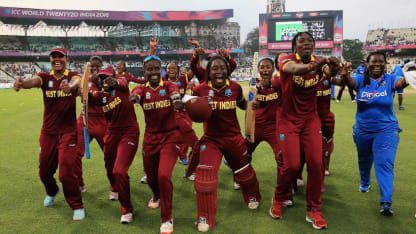Cricket
History of Cricket

India and Pakistan competing in the first ICC WT20 2007
21st Century Cricket
The 21st century has seen some of the most rapid changes in the history of the game, with arguably none bigger than the creation of a new format of the sport, the shortest version that is the three-hour spectacle of Twenty20 cricket.
The advent of Twenty20 cricket, played first in county cricket in England in 2003, has led to great innovation in the game. To counter free-scoring batsmen with big hitters and strokes played through all 360 degrees, bowlers began to perfect a great variety of different deliveries and there has been a sharp increase in the quality of fielding. In 2004, the first Women’s Twenty20 International was played and the following year saw the first Men’s Twenty20 International with the format being adopted as the third official format of the sport.
In September 2007, India's victory over Pakistan in the final of the first ever ICC World Twenty20, played in Johannesburg, drew a worldwide TV audience of more than 400 million. This was the catalyst for the creation of the Indian Premier League the following year. With further Twenty20 leagues launched around the world, modern cricketers in the 21st century are faced with playing cricket year-round.
The new century also saw the ICC introducing a “Test Championship Table” in 2001. The following year, a “One-day International Championship Table” was introduced. These have evolved into what are now the official MRF Tyres ICC Team Rankings across all three formats of the game with the leaders of the Test rankings holding the ICC Test Championship Mace.

Women's Cricket has developed significantly
The ICC also expanded its development programme, aiming to produce more national teams capable of competing at the various formats. In 2004, the ICC Intercontinental Cup brought first-class cricket to 12 nations, mostly for the first time, whilst the World Cricket League structure brought competitive limited overs-cricket to many new countries and there was memorable successes for some associate nations on the global stage with Kenya, Ireland, Afghanistan and the Netherlands all producing famous victories at ICC Global Events.
Afghanistan and Ireland were rewarded for their consistent performances both off and on the field resulting in the significant development and growth of cricket in their respective countries with Full-Member status in June 2017, taking the number to 12.
There have been innovations on the pitch too, with the introduction in Limited Overs cricket including Power-plays affecting the fielding restrictions, using two new balls in One Day Internationals and even dug-outs for the incoming batsmen in Twenty20 cricket. There was a huge development in Test Match cricket too as the Adelaide Oval played host to the first ever day-night Test Match between Australia and New Zealand using a specially developed pink ball.

Associate nation success in 21st Century
There have also been many recent technological evolutions in the game such as ball tracking, flashing stumps and bails for ensuring accurate run out decisions, infra-red cameras and edge detection technology can be used to see whether the bat has hit the ball and the Duckworth-Lewis-Stern method used to calculate targets and results in the event of unfavourable weather in limited-overs matches.
In 2008, a new referral system, in which players were allowed to refer some on-field decisions to the third umpire, made its international debut in a series between India and Sri Lanka. This has evolved to become the official Decision Review System.